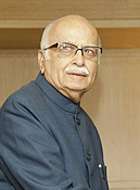Indian general election, 1989
| | |||||||||||||||||||||||||||||||||||||||||||||||||||
| |||||||||||||||||||||||||||||||||||||||||||||||||||
| |||||||||||||||||||||||||||||||||||||||||||||||||||
| |||||||||||||||||||||||||||||||||||||||||||||||||||
General elections were held in India in 1989 to elect the members of the 9th Lok Sabha.[2] The result was a loss for the Indian National Congress and Rajiv Gandhi, because all the opposition parties formed together a minority government under V. P. Singh and the National Front. The National Front was able to secure the first minority government, since 1947 Independence, with the help of the Left Parties and Bharatiya Janata Party. The Communists and the BJP declined to serve in the government, preferring to support it from outside.
Background
The 1989 Indian general election were held because the previous Lok Sabha has been in power for a five years, and the constitution allowed for new elections. Even though Rajiv Gandhi had won the last election by a landslide, this election saw him trying to fight off scandals that had marred his administration.
The Bofors scandal, rising terrorism in Punjab, the civil war between LTTE and Sri Lankan government were just some of the problems that stared at Rajiv's government. Rajiv's biggest critic was Vishwanath Pratap Singh, who had held the portfolios of the finance ministry and the defence ministry in the government. During Singh's term as defence minister it was rumoured that he possessed damaging information about the Bofors defence deal that could ruin Rajiv's reputation.
But Singh was soon sacked from the Cabinet and he then resigned from his memberships in the Congress and the Lok Sabha. He formed the Jan Morcha with Arun Nehru and Arif Mohammad Khan and re-entered the Lok Sabha from Allahabad. Witnessing V P Singh's meteoric rise on national stage, Rajiv tried to counter[3] him with another prominent Rajput stalwart Satyendra Narain Singh but failed eventually
Fight for premiership
V.P. Singh as Prime Minister
In a dramatic meeting in the Central Hall of Parliament on 1 December, V. P. Singh proposed the name of Devi Lal as Prime Minister, in spite of the fact that he himself had been clearly projected by the anti-Congress forces as the 'clean' alternative to Rajiv and their Prime Ministerial candidate. Devi Lal, a Jat leader from Haryana stood up and refused the nomination, and said that he would prefer to be an 'elder uncle' to the Government, and that Singh should be PM.[4] This last part came as a clear surprise to Chandra Shekhar, the former head of the erstwhile Janata Party, and Singh's greatest rival within the Janata Dal. Shekhar, who had clearly expected that an agreement had been forged with Lal as the consensus candidate, stormed out of the meeting and refused to serve in the Cabinet.
Chandra Sekhar as Prime Minister
Chandra Shekhar broke away from the Janata Dal with 64 MPs and formed the Samajwadi Janata Party in 1990. He got outside support from the Congress and became the 11th Prime Minister of India. He finally resigned on 6 March 1991, after the Congress alleged that the government was spying on Rajiv Gandhi.
 |
| This article is part of a series on the politics and government of India |
|
|
1989
9th Lok Sabha constituted.[5]
See also
- State Assembly elections in India, 1989
- Election Commission of India
- Indian presidential election, 1987
References
- ↑ http://www.ipu.org/parline-e/reports/arc/2145_89.htm
- ↑ "Elections 1989: Congress(I) faces prospect of being routed in Bihar".
- ↑ http://www.tribuneindia.com/2006/20060907/edit.htm
- ↑ Man in the News; V. P. Singh: Low-key Indian in high-anxiety job - New York Times report
- ↑ http://eci.nic.in/eci_main/statisticalreports/LS_1989/Vol_I_LS_89.pdf
.jpg)
.jpg)
